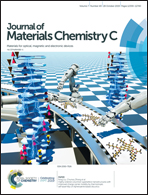Chiral EDT-TTF precursors with one stereogenic centre: substituent size modulation of the conducting properties in the (R-EDT-TTF)2PF6 (R = Me or Et) series†
Abstract
Modulation of the packing of the donors in the solid state and of the conducting behaviour is achieved in chiral radical cation salts based on the mono-alkylated donors methyl-ethylenedithio-tetrathiafulvalene (Me-EDT-TTF 1) and ethyl-ethylenedithio-tetrathiafulvalene (Et-EDT-TTF 2), underlining the paramount role of the number of stereogenic centres and substituent steric hindrance. Both donors have been prepared as racemates and then separated as pure enantiomers by chiral HPLC. Electrocrystallization experiments provided two complete series of crystalline radical cation salts formulated as [(R)-1]2PF6, [(S)-1]2PF6, and [(rac)-1]2PF6 and [(R)-2]2PF6, [(S)-2]2PF6 and [(rac)-2]PF6·(THF), respectively. The mixed valence salts of 1 show metal-like conductivity in the high temperature regime, while the radical cation salts of 2 are semiconductors, with a much higher conductivity for the enantiopure compounds than the racemic one. Tight-binding band structure calculations of the extended Hückel type performed for all the materials explain the observed conducting behaviour and show the differences in the intermolecular interactions triggered by the change of substituent between 1 and 2.



 Please wait while we load your content...
Please wait while we load your content...